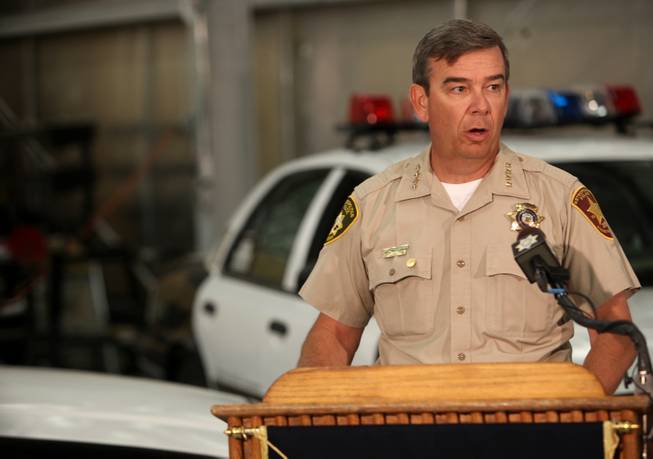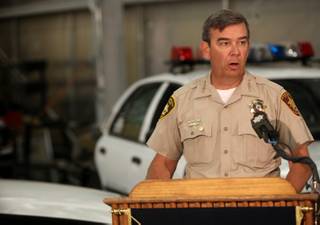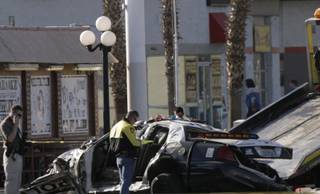
Sheriff Doug Gillespie addresses the media Tuesday morning to discuss a police crash that killed one officer and left another officer injured earlier this month.
Published Tuesday, Oct. 20, 2009 | 11:08 a.m.
Updated Tuesday, Oct. 20, 2009 | 6:07 p.m.
Sheriff Discusses Crash
Sheriff Gillespie held a press conference Tuesday to discuss the latest information on a fatal police crash.
Sun Archives
Metro Police Officer David Nesheiwat is recovering in an intermediate care facility from a patrol car crash that killed fellow Officer Milburn Beitel on Oct. 7 — a crash that could have been prevented, Sheriff Doug Gillespie said today.
"Both this community and members of Metro deserve to know what happened that fateful night," Gillespie said this morning during a news conference at an office complex and police garage on West Cheyenne Avenue.
Gillespie said that neither officer was wearing a seatbelt when the crash occurred. Beitel was driving the patrol car north on Nellis Boulevard when an unidentified car turned left in front of them.
Beitel was thrown from the car after it struck a tree and a light pole, Gillespie said. "This death was preventable," he said.
The officers had been investigating an odor and had no lights or sirens on at the time of the crash, Gillespie said. The car was going 71 mph in a posted 45 mph speed zone. As the other driver turned left, the patrol car swerved to avoid it, the sheriff said.
Metro Police haven't been able to find the driver of the other car, Gillespie said. Although police would like to talk to the driver of the car that was turning, the person would not face charges, and neither will Nesheiwat, Gillespie said.
Police said the vehicle observed by witnesses turning in front of the patrol car was going south on Nellis Boulevard, making a left turn onto eastbound Washington Avenue.
Both north and southbound traffic on Nellis Boulevard had a green light. The driver of the vehicle that turned left had a "permissive" green turn light, which means the vehicle could make a left turn if it was clear to safely do so.
All facts discovered in the investigation so far point to the Metro Police vehicle having the right of way, Gillespie said.
The patrol car being driven by the officers that night had been serviced every 3,000 miles on a regular basis by an authorized automotive dealer. Services included maintenance on braking and steering systems. The vehicle was last serviced Sept. 4. The brake pads, rotors and drums were inspected and within manufacturer's specifications.
Nesheiwat faces a long recovery, Gillespie said. The sheriff said he spoke to Nesheiwat on Monday, but he does not remember the details of the crash. Both air bags deployed in the collision.
Officer Beitel is the second Metro Police officer to die in the past five months in a car collision that involved speed and failing to wear a seatbelt, Gillespie said. Officer James Manor was killed in a crash in May. He was driving more than 100 mph and struck a pickup truck going 91 mph on Flamingo Road. Manor also was not wearing a seatbelt.
The Metro policy for patrol officers is changing, beginning with education and training sessions for all police supervisors, Gillespie said.
"It's not just changing policy, it's changing education and a culture," Gillespie said. Officers will undergo more training and have to attend mandatory meetings, he said. Officers who fail to wear seatbelts will face disciplinary action.
Police on Tuesday also released details on the number of accidents its vehicle have been involved in.
Metro said any vehicle that contacts any object, including another police vehicle, becomes a reportable accident, even if there is no evidence of the contact on the Metro vehicle or the object. This includes backing into a trash can or landscaping rocks, hitting a curb and blowing a tire, putting a vehicle in park and having it roll forward into the bumper of a vehicle next to it and having a citizen's vehicle roll into a Metro vehicle at a stop light.
In 2007, Metro Police drivers were involved in 725 accidents, or one accident for about every 50,000 miles driven. In 409 of those accidents, the Metro driver was at fault.
In 2008, Metro drivers were involved in 718 accidents, or one accident for about every 52,000 miles. In 431 of those accidents, the Metro driver was at fault.
So far in 2009, Metro drivers have been involved in 529 accidents, or one accident for about every 60,000 miles driven. In 302 of those accidents, Metro drivers were at fault, police said.
In fiscal year 2008-2009, on a monthly basis, Metro drove its 2,000 vehicles slightly under 2 million miles per month. That equals 81 trips around the world.



Join the Discussion:
Check this out for a full explanation of our conversion to the LiveFyre commenting system and instructions on how to sign up for an account.
Full comments policy